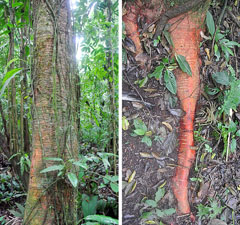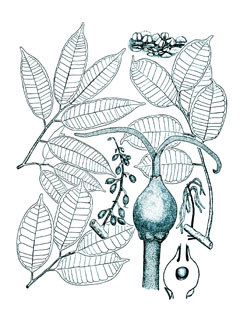 |
|
https://edibleplants.org/ |
 |
| https://edibleplants.org/ |
Translate this page:
Summary
Clarisia racemosa is a semideciduous, tropical, dioecious tree of about 40 m tall that usually grows in upland rainforests. It has oval or pear shaped fruits that are yellow, orange, or red in colour. The bark peels off revealing orange. The fleshy fruit stalk is edible. The crown is large, round and dense. The tree is harvested from the wild for its high quality timber that used for various purposes. The wood is moderately heavy, moderately hard, but very durable and very resistant to dry wood borers and termites.
Physical Characteristics

 Clarisia racemosa is a deciduous Tree growing to 25 m (82ft) by 20 m (65ft) at a medium rate.
Clarisia racemosa is a deciduous Tree growing to 25 m (82ft) by 20 m (65ft) at a medium rate.
See above for USDA hardiness. It is hardy to UK zone 10. The plant is not self-fertile.
Suitable for: medium (loamy) and heavy (clay) soils and prefers well-drained soil. Suitable pH: mildly acid, neutral and basic (mildly alkaline) soils. It can grow in semi-shade (light woodland) or no shade. It prefers moist soil.
UK Hardiness Map
US Hardiness Map
Synonyms
Clarisia nitida (Allem?o) J.F.Macbr. Olmedia erythrorhiza Huber ex Ducke Soaresia nitida Allem?o Sor
Plant Habitats
Edible Uses
Edible Parts: Fruit
Edible Uses:
The fruit stalk is fleshy and edible.
References More on Edible Uses
Medicinal Uses
Plants For A Future can not take any responsibility for any adverse effects from the use of plants. Always seek advice from a professional before using a plant medicinally.
None known
References More on Medicinal Uses
The Bookshop: Edible Plant Books
Our Latest books on Perennial Plants For Food Forests and Permaculture Gardens in paperback or digital formats.

Edible Tropical Plants
Food Forest Plants for Hotter Conditions: 250+ Plants For Tropical Food Forests & Permaculture Gardens.
More

Edible Temperate Plants
Plants for Your Food Forest: 500 Plants for Temperate Food Forests & Permaculture Gardens.
More

More Books
PFAF have eight books available in paperback and digital formats. Browse the shop for more information.
Shop Now
Other Uses
Furniture Wood
The tree yields a valuable timber and so is commonly harvested from the wild. The heartwood is bright yellow, becoming brown or russet, but retaining a golden lustre upon exposure; it is sharply demarcated from the 2 - 5cm wide band of white sapwood. The texture is medium to coarse; the grain variable, often decidedly roey with an attractive figure; dry specimens are without distinctive odour or taste. The wood is moderately heavy, moderately hard; very durable, but not if in contact with the soil, being very resistant to attacks by dry wood borers and termites. It seasons normally, with only a slight risk of checking or distortion; once dry it is moderately stable to stable in service. It is easy to work, though has a high blunting effect so stellite-tipped and tungsten carbide tools are recommended; it is rated fair to good in all machining operations; cross-grained material requires sharp tools to produce a smooth surface; fresh wood saws woolly; it does not take nails and screws well; glues and stains satisfactorily. A valued timber, it can be used for a wide range of purposes including making high-class furniture, cabinet work, panelling, joinery, tool handles, flooring, general construction and laminates[ 316 , 341 , 625 , 848 ].
Special Uses
References More on Other Uses
Cultivation details
Young plants grow best in the dappled shade of the woodland, becoming more light tolerant as they grow larger[ 625 ]. Prefers a clayey soil[ 625 ]. Young trees have a moderate rate of growth[ 625 ]. A dioecious species, both male and female forms need to be grown if fruit and seed are required[ 625 ].
References Carbon Farming Information and Carbon Sequestration Information
Temperature Converter
Type a value in the Celsius field to convert the value to Fahrenheit:
Fahrenheit:
The PFAF Bookshop
Plants For A Future have a number of books available in paperback and digital form. Book titles include Edible Plants, Edible Perennials, Edible Trees,Edible Shrubs, Woodland Gardening, and Temperate Food Forest Plants. Our new book is Food Forest Plants For Hotter Conditions (Tropical and Sub-Tropical).
Shop Now
Plant Propagation
Seed - best sown as soon as it is ripe in a partially shaded position in individual containers - placing 2 - 3 seeds in each container. A low germination rate can be expected, with the seed sprouting within 40 - 60 days[ 625 ].
Other Names
If available other names are mentioned here
Clarisia racemosa.Other Names: Bolivia: tulpay, mururŽ. Colombia: caraco, chili, arracacho. Ecuador: I matapalo. Peru: chichillica, guariuba. Brazil: oity.
Native Range
Coming Soon
Weed Potential
Right plant wrong place. We are currently updating this section.
Please note that a plant may be invasive in one area but may not in your area so it's worth checking.
None Known
Conservation Status
IUCN Red List of Threatened Plants Status : This taxon has not yet been assessed

Growth: S = slow M = medium F = fast. Soil: L = light (sandy) M = medium H = heavy (clay). pH: A = acid N = neutral B = basic (alkaline). Shade: F = full shade S = semi-shade N = no shade. Moisture: D = dry M = Moist We = wet Wa = water.
Now available:
Food Forest Plants for Mediterranean Conditions
350+ Perennial Plants For Mediterranean and Drier Food Forests and Permaculture Gardens.
[Paperback and eBook]
This is the third in Plants For A Future's series of plant guides for food forests tailored to
specific climate zones. Following volumes on temperate and tropical ecosystems, this book focuses
on species suited to Mediterranean conditions—regions with hot, dry summers and cool, wet winters,
often facing the added challenge of climate change.
Read More
Expert comment
Author
Ruiz & Pav.
Botanical References
Links / References
For a list of references used on this page please go here
A special thanks to Ken Fern for some of the information used on this page.
Readers comment
| Add a comment |
|
If you have important information about this plant that may help other users please add a comment or link below. Only comments or links that are felt to be directly relevant to a plant will be included. If you think a comment/link or information contained on this page is inaccurate or misleading we would welcome your feedback at [email protected]. If you have questions about a plant please use the Forum on this website as we do not have the resources to answer questions ourselves.
* Please note: the comments by website users are not necessarily those held by PFAF and may give misleading or inaccurate information.
To leave a comment please Register or login here All comments need to be approved so will not appear immediately.
|
Subject : Clarisia racemosa
|
|
|
|